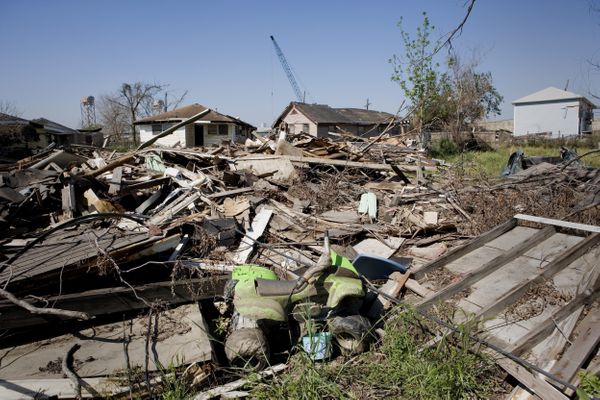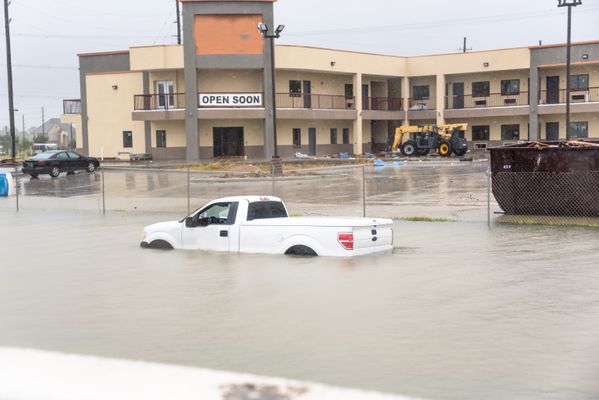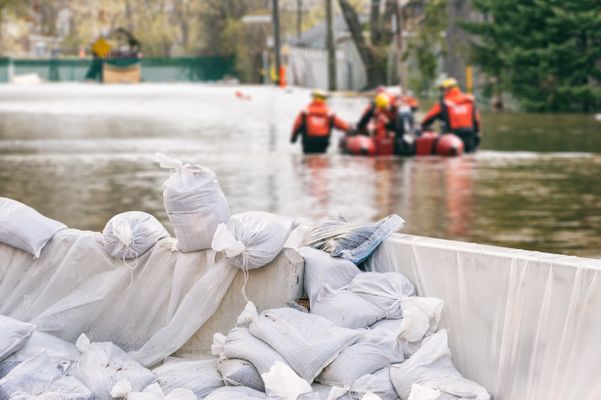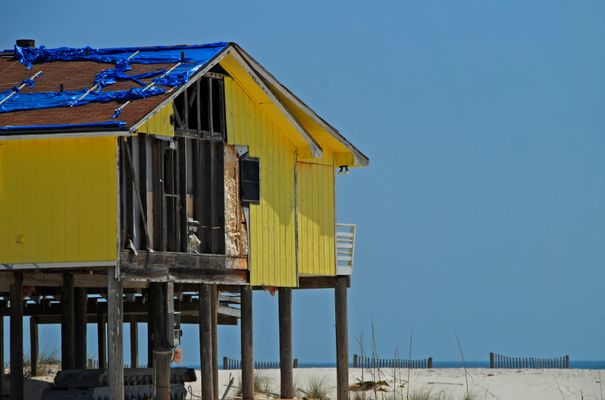1.3.14
Tropical Storms Case Study: Katrina
The Effects of Hurricane Katrina
The Effects of Hurricane Katrina
In August 2005, Hurricane Katrina hit the US states of Mississippi and Louisiana. It was the 3rd deadliest hurricane in American history. New Orleans' flood defenses (levees) broke because they were badly designed, flooding the city.


Primary effects
Primary effects
- 1,836 people are thought to have died.
- 154,522 houses were destroyed between 2005 and 2006.
- The electricity supplies for over 3 million people were cut off. Many people sheltered at the Superdome stadium in New Orleans.
- 80% of New Orleans was flooded with some parts 4.5 metres underwater.
- Coastal habitats were damaged and bridges & infrastructure collapsed.


Secondary effects
Secondary effects
- The population of New Orleans fell from 1.386 million to 1.04 million between 2005 and 2006. In 2014, the population was 1.25 million.
- 2,400 businesses in New Orleans closed down or went bankrupt between 2005 and 2006.
- Hundreds of thousands became homeless and sewers overflowed and entered water supplies.
- The estimated total amount of damage was around $125 billion.
The Responses to Hurricane Katrina
The Responses to Hurricane Katrina
The severe effects of Hurricane Katrina were met with both immediate and long-term responses.


Immediate responses
Immediate responses
- 1.7 million people were evacuated from the states of Mississippi and Louisiana before the storm struck.
- 20-30% of inhabitants were forced to stay in New Orleans and most of these people were the poorest who could not afford to evacuate.
- Louisiana's National Guard asked for more than 700 buses to evacuate people, however, only 100 buses were sent. States of emergency were declared in Mississippi and Louisiana.
- More than 35,000 people were rescued by the coastguard in New Orleans.
- Charities provided food, water, and aid to those affected.


Long-term responses
Long-term responses
- The waters that flooded New Orleans were pumped into Lake Pontchartrain. This took over a month.
- The US Congress (government) allocated $62bn to be spent in aid helping feed and re-house the victims of Hurricane Katrina.
- The US federal and state governments have spent $20 billion rebuilding New Orleans' flood defence systems, with levees, gates, pumps and floodwalls.
1The Challenge of Natural Hazards
1.1Natural Hazards
1.2Tectonic Hazards
1.2.1The Earth's Layers
1.2.2Tectonic Plates
1.2.3The Earth's Tectonic Plates
1.2.4Convection Currents
1.2.5Plate Margins
1.2.6Volcanoes
1.2.7Volcano Eruptions
1.2.8Effects of Volcanoes
1.2.9Primary Effects of Volcanoes
1.2.10Secondary Effects of Volcanoes
1.2.11Responses to Volcanic Eruptions
1.2.12Immediate Responses to Volcanoes
1.2.13Long-Term Responses to Volcanoes
1.2.14Earthquakes
1.2.15Earthquakes at Different Plate Margins
1.2.16What is an Earthquake?
1.2.17Measuring Earthquakes
1.2.18Immediate Responses to Earthquakes
1.2.19Long-Term Responses to Earthquakes
1.2.20Case Studies: The L'Aquila Earthquake
1.2.21Case Studies: The Kashmir Earthquake
1.2.22Earthquake Case Study: Chile 2010
1.2.23Earthquake Case Study: Nepal 2015
1.2.24Reducing the Impact of Tectonic Hazards
1.2.25Protecting & Planning
1.2.26Living with Tectonic Hazards 2
1.2.27End of Topic Test - Tectonic Hazards
1.2.28Exam-Style Questions - Tectonic Hazards
1.2.29Tectonic Hazards - Statistical Skills
1.3Weather Hazards
1.3.1Winds & Pressure
1.3.2The Global Atmospheric Circulation Model
1.3.3Surface Winds
1.3.4UK Weather Hazards
1.3.5Changing Weather in the UK
1.3.6Tropical Storms
1.3.7Tropical Storm Causes
1.3.8Features of Tropical Storms
1.3.9The Structure of Tropical Storms
1.3.10The Effect of Climate Change on Tropical Storms
1.3.11The Effects of Tropical Storms
1.3.12Responses to Tropical Storms
1.3.13Reducing the Effects of Tropical Storms
1.3.14Tropical Storms Case Study: Katrina
1.3.15Tropical Storms Case Study: Haiyan
1.3.16UK Weather Hazards Case Study: Somerset 2014
1.3.17End of Topic Test - Weather Hazards
1.3.18Exam-Style Questions - Weather Hazards
1.3.19Weather Hazards - Statistical Skills
1.4Climate Change
1.4.1Climate Change
1.4.2Evidence for Climate Change
1.4.3Natural Causes of Climate Change
1.4.4Human Causes of Climate Change
1.4.5Effects of Climate Change on the Environment
1.4.6Effects of Climate Change on People
1.4.7Climate Change Mitigation Strategies
1.4.8Adaptation to Climate Change
1.4.9End of Topic Test - Climate Change
1.4.10Exam-Style Questions - Climate Change
1.4.11Climate Change - Statistical Skills
2The Living World
2.1Ecosystems
2.2Tropical Rainforests
2.2.1Tropical Rainforests
2.2.2Interdependence of Tropical Rainforests
2.2.3Adaptations of Plants to Rainforests
2.2.4Adaptations of Animals to Rainforests
2.2.5Biodiversity of Tropical Rainforests
2.2.6Deforestation
2.2.7Impacts of Deforestation
2.2.8Case Study: Deforestation in the Amazon Rainforest
2.2.9Why Protect Rainforests?
2.2.10Sustainable Management of Rainforests
2.2.11Case Study: Malaysian Rainforest
2.2.12End of Topic Test - Tropical Rainforests
2.2.13Exam-Style Questions - Tropical Rainforests
2.2.14Deforestation - Statistical Skills
2.3Hot Deserts
2.3.1Hot Deserts
2.3.2Interdependence in Hot Deserts
2.3.3Adaptation of Plants to Hot Deserts
2.3.4Adaptation of Animals to Hot Deserts
2.3.5Biodiversity in Hot Deserts
2.3.6Case Study: Sahara Desert
2.3.7Desertification
2.3.8Reducing the Risk of Desertification
2.3.9Case Study: Thar Desert
2.3.10End of Topic Test - Hot Deserts
2.3.11Exam-Style Questions - Hot Deserts
2.4Tundra & Polar Environments
2.4.1Overview of Cold Environments
2.4.2Interdependence of Cold Environments
2.4.3Adaptations of Plants to Cold Environments
2.4.4Adaptations of Animals to Cold Environments
2.4.5Biodiversity in Cold Environments
2.4.6Case Study: Alaska
2.4.7Sustainable Management
2.4.8Case Study: Svalbard
2.4.9End of Topic Test - Tundra & Polar Environments
2.4.10Exam-Style Questions - Cold Environments
3Physical Landscapes in the UK
3.1The UK Physical Landscape
3.2Coastal Landscapes in the UK
3.2.1Types of Wave
3.2.2Weathering
3.2.3Mass Movement
3.2.4Processes of Erosion
3.2.5Wave-Cut Platforms
3.2.6Headlands & Bays
3.2.7Caves, Arches & Stacks
3.2.8Longshore Drift
3.2.9Sediment Transport
3.2.10Deposition
3.2.11Spits, Bars & Sand Dunes
3.2.12Coastal Management - Hard Engineering
3.2.13Coastal Management - Soft Engineering
3.2.14Case Study: Landforms on the Dorset Coast
3.2.15Coastal Management - Managed Retreat
3.2.16Coastal Management Case Study - Holderness
3.2.17Coastal Management Case Study: Swanage
3.2.18Coastal Management Case Study - Lyme Regis
3.2.19End of Topic Test - Coastal Landscapes in the UK
3.2.20Exam-Style Questions - Coasts
3.3River Landscapes in the UK
3.3.1The Long Profile of a River
3.3.2The Cross Profile of a River
3.3.3Vertical & Lateral Erosion
3.3.4River Valley Case Study - River Tees
3.3.5Processes of Erosion
3.3.6Sediment Transport
3.3.7River Deposition
3.3.8Waterfalls & Gorges
3.3.9Interlocking Spurs
3.3.10Meanders
3.3.11Oxbow Lakes
3.3.12Floodplains
3.3.13Levees
3.3.14Estuaries
3.3.15Case Study: The River Clyde
3.3.16River Management
3.3.17Hydrographs
3.3.18Flood Defences - Hard Engineering
3.3.19Flood Defences - Soft Engineering
3.3.20River Management Case Study - Boscastle
3.3.21River Management Case Study - Banbury
3.3.22End of Topic Test - River Landscapes in the UK
3.3.23Exam-Style Questions - Rivers
3.4Glacial Landscapes in the UK
3.4.1The UK in the Last Ice Age
3.4.2Glacial Processes
3.4.3Glacial Landforms Caused by Erosion
3.4.4Tarns, Corries, Glacial Troughs & Truncated Spurs
3.4.5Types of Moraine
3.4.6Drumlins & Erratics
3.4.7Snowdonia
3.4.8Land Use in Glaciated Areas
3.4.9Conflicts in Glacial Landscapes
3.4.10Tourism in Glacial Landscapes
3.4.11Coping with Tourism Impacts in Glacial Landscapes
3.4.12Case Study - Lake District
3.4.13End of Topic Test - Glacial Landscapes in the UK
3.4.14Exam-Style Questions - Glacial Landscapes
4Urban Issues & Challenges
4.1Urban Issues & Challenges
4.1.1Urbanisation
4.1.2Factors Causing Urbanisation
4.1.3Megacities
4.1.4Urbanisation Case Study: Lagos
4.1.5Urbanisation Case Study: Rio de Janeiro
4.1.6UK Cities
4.1.7Case Study: Urban Regen Projects - Manchester
4.1.8Case Study: Urban Change in Liverpool
4.1.9Case Study: Urban Change in Bristol
4.1.10Sustainable Urban Life
4.1.11Reducing Traffic Congestion
4.1.12End of Topic Test - Urban Issues & Challenges
4.1.13Exam-Style Questions - Urban Issues & Challenges
4.1.14Urban Issues -Statistical Skills
5The Changing Economic World
5.1The Changing Economic World
5.1.1Measuring Development
5.1.2Limitations of Developing Measures
5.1.3Classifying Countries Based on Wealth
5.1.4The Demographic Transition Model
5.1.5Stages of the Demographic Transition Model
5.1.6Physical Causes of Uneven Development
5.1.7Historical Causes of Uneven Development
5.1.8Economic Causes of Uneven Development
5.1.9Consequences of Uneven Development
5.1.10How Can We Reduce the Global Development Gap?
5.1.11Case Study: Tourism in Kenya
5.1.12Case Study: Tourism in Jamaica
5.1.13Case Study: Economic Development in India
5.1.14Case Study: Aid & Development in India
5.1.15Case Study: Economic Development in Nigeria
5.1.16Case Study: Aid & Development in Nigeria
5.1.17End of Topic Test - The Changing Economic World
5.1.18Exam-Style Questions - The Changing Economic World
5.1.19Changing Economic World - Statistical Skills
5.2Economic Development in the UK
6The Challenge of Resource Management
6.1Resource Management
6.1.1Global Distribution of Resources
6.1.2Uneven Distribution of Resources
6.1.3Food in the UK
6.1.4Agribusiness
6.1.5Demand for Water in the UK
6.1.6Water Pollution in the UK
6.1.7Matching Supply & Demand of Water in the UK
6.1.8The UK's Energy Mix
6.1.9Issues with Sources of Energy
6.1.10Resource Management - Statistical Skills
6.2Food
6.2.1Areas of Food Surplus & Food Deficit
6.2.2Increasing Food Consumption
6.2.3Food Supply & Food Insecurity
6.2.4Impacts of Food Insecurity
6.2.5Increasing Food Supply
6.2.6Case Study: Thanet Earth
6.2.7Creating a Sustainable Food Supply
6.2.8Case Study: Agroforestry in Mali
6.2.9End of Topic Test - Food
6.2.10Exam-Style Questions - Food
6.2.11Food - Statistical Skills
6.3Water
6.3.1Water Surplus & Water Deficit
6.3.2Increasing Water Consumption
6.3.3What Affects the Availability of Water?
6.3.4Impacts of Water Insecurity
6.3.5Increasing Water Supplies
6.3.6Case Study: Water Transfer in China
6.3.7Sustainable Water Supply
6.3.8Case Study: Kenya's Sand Dams
6.3.9Case Study: Lesotho Highland Water Project
6.3.10Case Study: Wakel River Basin Project
6.3.11Exam-Style Questions - Water
6.3.12Water - Statistical Skills
6.4Energy
6.4.1Global Demand for Energy
6.4.2Increasing Energy Consumption
6.4.3Factors Affecting Energy Supply
6.4.4Impacts of Energy Insecurity
6.4.5Increasing Energy Supply - Solar
6.4.6Increasing Energy Supply - Water
6.4.7Increasing Energy Supply - Wind
6.4.8Increasing Energy Supply - Nuclear
6.4.9Increasing Energy Supply - Fossil Fuels
6.4.10Carbon Footprints
6.4.11Energy Conservation
6.4.12Case Study: Rice Husks in Bihar
6.4.13Exam-Style Questions - Energy
6.4.14Energy - Statistical Skills
Jump to other topics
1The Challenge of Natural Hazards
1.1Natural Hazards
1.2Tectonic Hazards
1.2.1The Earth's Layers
1.2.2Tectonic Plates
1.2.3The Earth's Tectonic Plates
1.2.4Convection Currents
1.2.5Plate Margins
1.2.6Volcanoes
1.2.7Volcano Eruptions
1.2.8Effects of Volcanoes
1.2.9Primary Effects of Volcanoes
1.2.10Secondary Effects of Volcanoes
1.2.11Responses to Volcanic Eruptions
1.2.12Immediate Responses to Volcanoes
1.2.13Long-Term Responses to Volcanoes
1.2.14Earthquakes
1.2.15Earthquakes at Different Plate Margins
1.2.16What is an Earthquake?
1.2.17Measuring Earthquakes
1.2.18Immediate Responses to Earthquakes
1.2.19Long-Term Responses to Earthquakes
1.2.20Case Studies: The L'Aquila Earthquake
1.2.21Case Studies: The Kashmir Earthquake
1.2.22Earthquake Case Study: Chile 2010
1.2.23Earthquake Case Study: Nepal 2015
1.2.24Reducing the Impact of Tectonic Hazards
1.2.25Protecting & Planning
1.2.26Living with Tectonic Hazards 2
1.2.27End of Topic Test - Tectonic Hazards
1.2.28Exam-Style Questions - Tectonic Hazards
1.2.29Tectonic Hazards - Statistical Skills
1.3Weather Hazards
1.3.1Winds & Pressure
1.3.2The Global Atmospheric Circulation Model
1.3.3Surface Winds
1.3.4UK Weather Hazards
1.3.5Changing Weather in the UK
1.3.6Tropical Storms
1.3.7Tropical Storm Causes
1.3.8Features of Tropical Storms
1.3.9The Structure of Tropical Storms
1.3.10The Effect of Climate Change on Tropical Storms
1.3.11The Effects of Tropical Storms
1.3.12Responses to Tropical Storms
1.3.13Reducing the Effects of Tropical Storms
1.3.14Tropical Storms Case Study: Katrina
1.3.15Tropical Storms Case Study: Haiyan
1.3.16UK Weather Hazards Case Study: Somerset 2014
1.3.17End of Topic Test - Weather Hazards
1.3.18Exam-Style Questions - Weather Hazards
1.3.19Weather Hazards - Statistical Skills
1.4Climate Change
1.4.1Climate Change
1.4.2Evidence for Climate Change
1.4.3Natural Causes of Climate Change
1.4.4Human Causes of Climate Change
1.4.5Effects of Climate Change on the Environment
1.4.6Effects of Climate Change on People
1.4.7Climate Change Mitigation Strategies
1.4.8Adaptation to Climate Change
1.4.9End of Topic Test - Climate Change
1.4.10Exam-Style Questions - Climate Change
1.4.11Climate Change - Statistical Skills
2The Living World
2.1Ecosystems
2.2Tropical Rainforests
2.2.1Tropical Rainforests
2.2.2Interdependence of Tropical Rainforests
2.2.3Adaptations of Plants to Rainforests
2.2.4Adaptations of Animals to Rainforests
2.2.5Biodiversity of Tropical Rainforests
2.2.6Deforestation
2.2.7Impacts of Deforestation
2.2.8Case Study: Deforestation in the Amazon Rainforest
2.2.9Why Protect Rainforests?
2.2.10Sustainable Management of Rainforests
2.2.11Case Study: Malaysian Rainforest
2.2.12End of Topic Test - Tropical Rainforests
2.2.13Exam-Style Questions - Tropical Rainforests
2.2.14Deforestation - Statistical Skills
2.3Hot Deserts
2.3.1Hot Deserts
2.3.2Interdependence in Hot Deserts
2.3.3Adaptation of Plants to Hot Deserts
2.3.4Adaptation of Animals to Hot Deserts
2.3.5Biodiversity in Hot Deserts
2.3.6Case Study: Sahara Desert
2.3.7Desertification
2.3.8Reducing the Risk of Desertification
2.3.9Case Study: Thar Desert
2.3.10End of Topic Test - Hot Deserts
2.3.11Exam-Style Questions - Hot Deserts
2.4Tundra & Polar Environments
2.4.1Overview of Cold Environments
2.4.2Interdependence of Cold Environments
2.4.3Adaptations of Plants to Cold Environments
2.4.4Adaptations of Animals to Cold Environments
2.4.5Biodiversity in Cold Environments
2.4.6Case Study: Alaska
2.4.7Sustainable Management
2.4.8Case Study: Svalbard
2.4.9End of Topic Test - Tundra & Polar Environments
2.4.10Exam-Style Questions - Cold Environments
3Physical Landscapes in the UK
3.1The UK Physical Landscape
3.2Coastal Landscapes in the UK
3.2.1Types of Wave
3.2.2Weathering
3.2.3Mass Movement
3.2.4Processes of Erosion
3.2.5Wave-Cut Platforms
3.2.6Headlands & Bays
3.2.7Caves, Arches & Stacks
3.2.8Longshore Drift
3.2.9Sediment Transport
3.2.10Deposition
3.2.11Spits, Bars & Sand Dunes
3.2.12Coastal Management - Hard Engineering
3.2.13Coastal Management - Soft Engineering
3.2.14Case Study: Landforms on the Dorset Coast
3.2.15Coastal Management - Managed Retreat
3.2.16Coastal Management Case Study - Holderness
3.2.17Coastal Management Case Study: Swanage
3.2.18Coastal Management Case Study - Lyme Regis
3.2.19End of Topic Test - Coastal Landscapes in the UK
3.2.20Exam-Style Questions - Coasts
3.3River Landscapes in the UK
3.3.1The Long Profile of a River
3.3.2The Cross Profile of a River
3.3.3Vertical & Lateral Erosion
3.3.4River Valley Case Study - River Tees
3.3.5Processes of Erosion
3.3.6Sediment Transport
3.3.7River Deposition
3.3.8Waterfalls & Gorges
3.3.9Interlocking Spurs
3.3.10Meanders
3.3.11Oxbow Lakes
3.3.12Floodplains
3.3.13Levees
3.3.14Estuaries
3.3.15Case Study: The River Clyde
3.3.16River Management
3.3.17Hydrographs
3.3.18Flood Defences - Hard Engineering
3.3.19Flood Defences - Soft Engineering
3.3.20River Management Case Study - Boscastle
3.3.21River Management Case Study - Banbury
3.3.22End of Topic Test - River Landscapes in the UK
3.3.23Exam-Style Questions - Rivers
3.4Glacial Landscapes in the UK
3.4.1The UK in the Last Ice Age
3.4.2Glacial Processes
3.4.3Glacial Landforms Caused by Erosion
3.4.4Tarns, Corries, Glacial Troughs & Truncated Spurs
3.4.5Types of Moraine
3.4.6Drumlins & Erratics
3.4.7Snowdonia
3.4.8Land Use in Glaciated Areas
3.4.9Conflicts in Glacial Landscapes
3.4.10Tourism in Glacial Landscapes
3.4.11Coping with Tourism Impacts in Glacial Landscapes
3.4.12Case Study - Lake District
3.4.13End of Topic Test - Glacial Landscapes in the UK
3.4.14Exam-Style Questions - Glacial Landscapes
4Urban Issues & Challenges
4.1Urban Issues & Challenges
4.1.1Urbanisation
4.1.2Factors Causing Urbanisation
4.1.3Megacities
4.1.4Urbanisation Case Study: Lagos
4.1.5Urbanisation Case Study: Rio de Janeiro
4.1.6UK Cities
4.1.7Case Study: Urban Regen Projects - Manchester
4.1.8Case Study: Urban Change in Liverpool
4.1.9Case Study: Urban Change in Bristol
4.1.10Sustainable Urban Life
4.1.11Reducing Traffic Congestion
4.1.12End of Topic Test - Urban Issues & Challenges
4.1.13Exam-Style Questions - Urban Issues & Challenges
4.1.14Urban Issues -Statistical Skills
5The Changing Economic World
5.1The Changing Economic World
5.1.1Measuring Development
5.1.2Limitations of Developing Measures
5.1.3Classifying Countries Based on Wealth
5.1.4The Demographic Transition Model
5.1.5Stages of the Demographic Transition Model
5.1.6Physical Causes of Uneven Development
5.1.7Historical Causes of Uneven Development
5.1.8Economic Causes of Uneven Development
5.1.9Consequences of Uneven Development
5.1.10How Can We Reduce the Global Development Gap?
5.1.11Case Study: Tourism in Kenya
5.1.12Case Study: Tourism in Jamaica
5.1.13Case Study: Economic Development in India
5.1.14Case Study: Aid & Development in India
5.1.15Case Study: Economic Development in Nigeria
5.1.16Case Study: Aid & Development in Nigeria
5.1.17End of Topic Test - The Changing Economic World
5.1.18Exam-Style Questions - The Changing Economic World
5.1.19Changing Economic World - Statistical Skills
5.2Economic Development in the UK
6The Challenge of Resource Management
6.1Resource Management
6.1.1Global Distribution of Resources
6.1.2Uneven Distribution of Resources
6.1.3Food in the UK
6.1.4Agribusiness
6.1.5Demand for Water in the UK
6.1.6Water Pollution in the UK
6.1.7Matching Supply & Demand of Water in the UK
6.1.8The UK's Energy Mix
6.1.9Issues with Sources of Energy
6.1.10Resource Management - Statistical Skills
6.2Food
6.2.1Areas of Food Surplus & Food Deficit
6.2.2Increasing Food Consumption
6.2.3Food Supply & Food Insecurity
6.2.4Impacts of Food Insecurity
6.2.5Increasing Food Supply
6.2.6Case Study: Thanet Earth
6.2.7Creating a Sustainable Food Supply
6.2.8Case Study: Agroforestry in Mali
6.2.9End of Topic Test - Food
6.2.10Exam-Style Questions - Food
6.2.11Food - Statistical Skills
6.3Water
6.3.1Water Surplus & Water Deficit
6.3.2Increasing Water Consumption
6.3.3What Affects the Availability of Water?
6.3.4Impacts of Water Insecurity
6.3.5Increasing Water Supplies
6.3.6Case Study: Water Transfer in China
6.3.7Sustainable Water Supply
6.3.8Case Study: Kenya's Sand Dams
6.3.9Case Study: Lesotho Highland Water Project
6.3.10Case Study: Wakel River Basin Project
6.3.11Exam-Style Questions - Water
6.3.12Water - Statistical Skills
6.4Energy
6.4.1Global Demand for Energy
6.4.2Increasing Energy Consumption
6.4.3Factors Affecting Energy Supply
6.4.4Impacts of Energy Insecurity
6.4.5Increasing Energy Supply - Solar
6.4.6Increasing Energy Supply - Water
6.4.7Increasing Energy Supply - Wind
6.4.8Increasing Energy Supply - Nuclear
6.4.9Increasing Energy Supply - Fossil Fuels
6.4.10Carbon Footprints
6.4.11Energy Conservation
6.4.12Case Study: Rice Husks in Bihar
6.4.13Exam-Style Questions - Energy
6.4.14Energy - Statistical Skills

Unlock your full potential with GoStudent tutoring
Affordable 1:1 tutoring from the comfort of your home
Tutors are matched to your specific learning needs
30+ school subjects covered